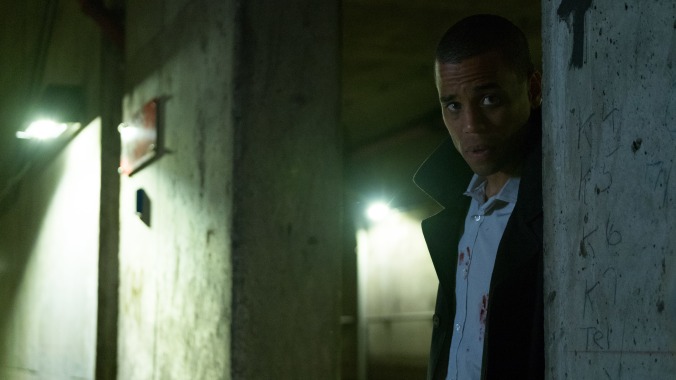Though it died a pretty swift death at the box office in the fall of 1990, Adrian Lyne’s hallucinatory horror freakout Jacob’s Ladder has gone on to a better place, climbing to an afterlife of cult fandom. Written by Joel Bruce Rubin, whose script sat on the Hollywood blacklist for a solid decade, the film fancied itself a “psychological thriller,” following as it did a Vietnam veteran (Tim Robbins) plagued by either glimpses of the netherworld or just some advanced, possibly drug-enhanced form of PTSD. But Jacob’s Ladder probably endures less for its grave subject matter than its memorably, influentially creepy special effects, doled out in grotesque flashes: spooky faces in passing subway cars; a horned, horny monstrosity stalking a dance floor; and in the most microcosmic of the movie’s scares, a bumpy gurney ride into the depths of a truly hellish hospital. It was funhouse schlock with pretensions of seriousness, but a lot of its visual ideas oozed their way into the genre gene pool.
The new Jacob’s Ladder, creeping quietly into theaters this week after an even quieter DISH premiere, doesn’t skimp on the demonic visions, exactly. There are, again, shape-shifting vagrants, skittering around the edges of the frame, their faces suddenly twisting from normal to Halloween-mask frightening. And the film offers its own doses of Lyne’s trippiest and most imitated trick: heads jerking around on necks in a fast-motion blur, like the wings of a dragonfly. Yet there’s something curiously perfunctory about these unholy encounters—and not just because the phantoms have been conjured, unconvincingly, from computers this time. David M. Rosenthal, the director, stages the scares with little imagination or verve; they come across like a begrudging sop to horror fans, stuck in there purely out of obligation. Why remake Jacob’s Ladder if you’re not going to try to compete at all with its nightmare fuel, the very element that earned it a following and, you know, a remake?
It’d be one thing if Rosenthal was downplaying the phantasmagoria in favor of a richer portrait of post-war life. But even the character drama feels half-assed. It revolves, again, around combat veteran Jacob Singer (Michael Ealy), haunted by strange sights and ominous figures. This time around, he isn’t a postal worker but a surgeon for the local VA. And he fought in the Middle East, not ’Nam—a tour of service the movie occasionally depicts through streaky, generic flashbacks that recall any American movie about the war in Iraq. Jacob has married and fathered a son with Samantha (Nikki Beharie), who once dated his brother, Isaac (Jesse Williams). This preys a little on his conscience—in part, perhaps, because Isaac was killed in the same conflict overseas. Or was he?
The sibling relationship is one way that Jacob’s Ladder breaks from the template of its predecessor. The screenplay was co-written by Jeff Buhler, who also worked on the script for this past spring’s Pet Sematary, and as with that remake of a three-decade-old horror touchstone, there’s a real sense that the plot tweaks aren’t so much improvements as simply deviations for the sake of deviating. Not that the movie is above recycling signature shots and scenes: a desperate plunge into an icy bath; a fevered pursuit down a narrow alley; a nearly verbatim speech about the living hell of unfinished business.
Ealy, who chilled his leading-man charm into a stalker menace in Rosenthal’s The Perfect Guy, does frazzled well enough. Like most of his costars, he labors hard to bring some emotional sense to a story that’s been reduced to an 89-minute husk. Really exploring the reality of Jacob’s post-service existence—his marriage, his relationship to the city—would have required a few scenes not designed to mercenarily push the plot forward or set up future developments, like the reveal of a “secret” villain any astute viewer will identify upon polite appearance one. Lyne’s movie may have been stylish pulp with the veneer of art, but there was poignancy to the way it acknowledged how triggering the city can be for a veteran. Relocating the action from New York to Atlanta, this Jacob’s Ladder never supplies its urban backdrop a personality, hostile or otherwise. It doesn’t help that everything looks digitally flat and cheap, with nary a hint of the texture Lyne’s celluloid cinematography provided.
If the original is remembered for something other than its scary-gross imagery, it’s probably for its ending: a proto-Sixth Sense rug pull calibrated to blow minds, even if it ultimately didn’t make a ton of sense in the context of Rubin’s study of how soldiers survive their survival. In the last of its significant changes, the modern version jettisons that final reveal in favor of a new twist, one built on the mirages that people sometimes create to deal with their trauma. It’s absurdly elaborate, but might have packed some real punch if the film on a whole wasn’t so workmanlike, and so ultimately disinterested in psychology. This Jacob’s Ladder isn’t likely to build much of a fanbase over the next 30 years. It’ll be lucky if anyone remembers it for 30 minutes.










![HBO teases new Euphoria, Larry David, and much more in 2026 sizzle reel [Updated]](https://img.pastemagazine.com/wp-content/avuploads/2025/12/12100344/MixCollage-12-Dec-2025-09-56-AM-9137.jpg)































